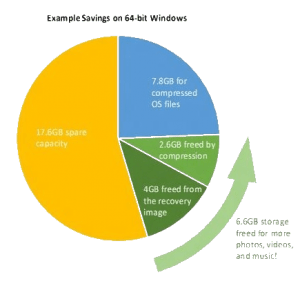In an effort to both improve performance and decrease the footprint of Windows 10, Microsoft has compacted it into a smaller package through several techniques:
- Windows Vista 7 and 8 had a “Recovery Partition” that was hidden but still consumed between 4GB and 12GB of disk space. That partition was used to store system files which could be restored in the event of a failure. Microsoft has rearchitected Windows 10 to rely on the existing system files. The best part of this, beyond
 the disk savings, is that repairs WILL use any Windows Updated files on your computer, so after a repair, you will not have repatch hundreds of files. . If you are worried about a serious crash or complete failure, you can now create your own Windows 10 backup media (DVD or USB stick). For details read our http://www.urtech.ca/2015/07/solved-how-to-do-a-clean-install-of-windows-10-without-a-product-key/ .
the disk savings, is that repairs WILL use any Windows Updated files on your computer, so after a repair, you will not have repatch hundreds of files. . If you are worried about a serious crash or complete failure, you can now create your own Windows 10 backup media (DVD or USB stick). For details read our http://www.urtech.ca/2015/07/solved-how-to-do-a-clean-install-of-windows-10-without-a-product-key/ . - Windows has used NTFS for many years and that file system supports compressing individual files and folders. It also decompresses them very quickly on the fly. Many system files are only infrequently used so Microsoft has saved 2.6GB of disk by compressing system files.
We see that it is normal for a Windows 10 machine SAVE 10GB of space after an upgrade from Windows 7 or 8. Take note that if you have a small screen of 8″ or less, you will NOT be able to install programs from anywhere but the Store (i.e. you will not be able to install MS Word from a DVD). See THIS post for more details.



0 Comments